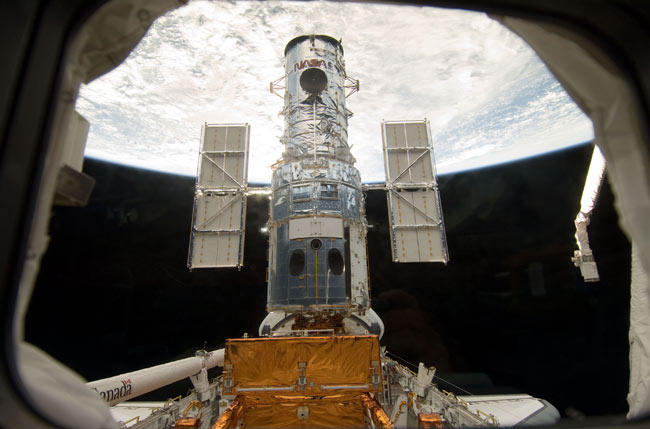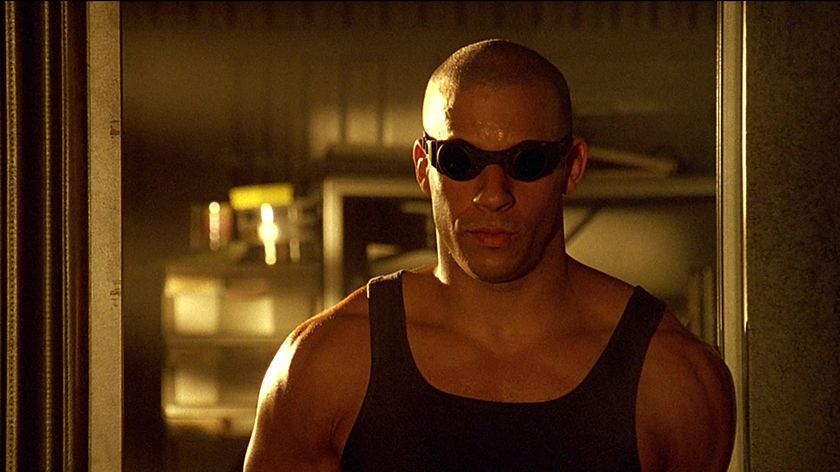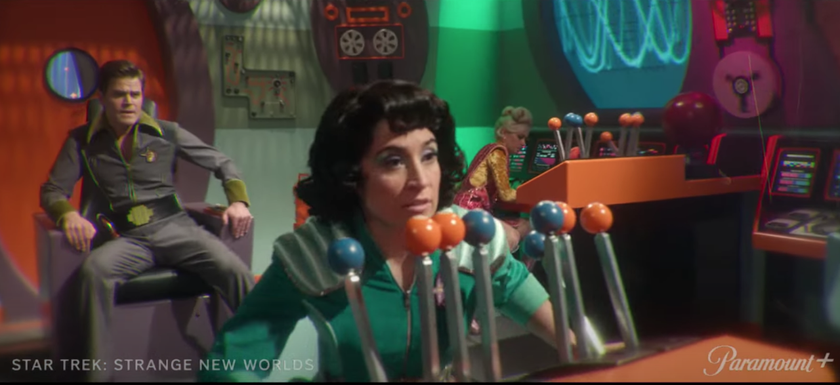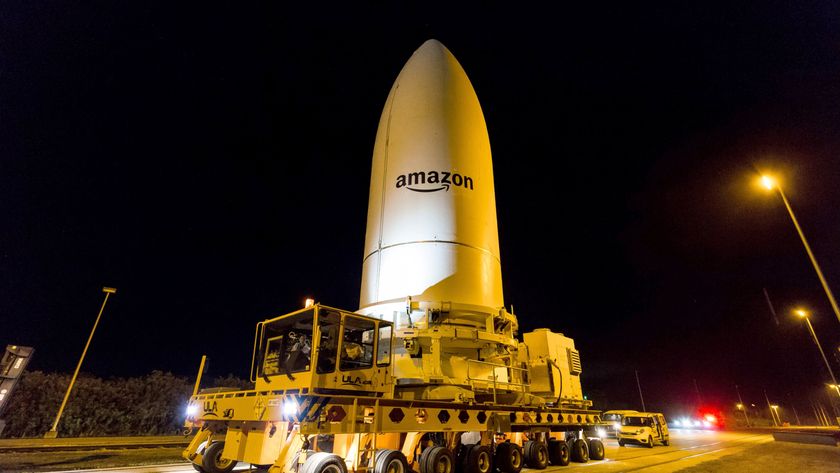New 3D Film Makes Hubble Space Telescope a Star

The Hubble Space Telescope has long been an icon of astronomy, with $10 billion spent over two decades to keep it peering deep into the cosmos. Now a new IMAX film is taking that space icon and turning it into a 3D star.
The film — Hubble3D — opens in select IMAX theaters on Friday and chronicles NASA's May 2009 mission that sent a crew of astronauts to repair and overhaul the nearly 20-year-old Hubble for the fifth and final time. The 43-minute film seeks to bring Hubble, which orbits 350 miles (563 km) above the planet, down to Earth and includes stunning 3D flights through photos of the Orion Nebula and other images taken by the space telescope after its latest service call.
"I was astonished at how moved I was by the astronomical fly-through of the images," Hubble 3D director Toni Myers told SPACE.com. "I kind of had a vision of how they would be, but the execution was beyond my wildest dreams."
The film is narrated by actor Leonardo DiCaprio, whom Myers said has a keen interest in Hubble's ability to put Earth's life-sustaining uniqueness in perspective with the rest of the universe.
"Hubble 3D" gives you a real perspective on how our small and fragile planet exists in a volatile and constantly evolving universe," DiCaprio said in a statement. "It reveals the beauty and complexity of space and its vast possibilities."
It's a story that almost never happened, since NASA initially canceled the last Hubble repair mission, deciding it was too risky in the wake of the 2003 Columbia tragedy. That decision was ultimately reversed. Then a critical piece on Hubble broke just weeks before the mission was slated to launch in the fall of 2008. NASA delayed the flight again, to May 2009, so a fix could be added to the flight.
The astronauts who flew Atlantis' Hubble repair mission said they were just glad the glitch occurred before their flight and not afterward, when they wouldn't have a chance to fix it. The STS-125crew, commanded by veteran shuttle flyer Scott Altman, added that seeing their mission replayed in 3D on an expansive IMAX screen gave them a chance to relive the flight all over again.
Get the Space.com Newsletter
Breaking space news, the latest updates on rocket launches, skywatching events and more!
"Forme, it's just increasing our understanding about what's out there," said astronaut Mike Massimino, one of Hubble's last spacewalking repairmen and a veteran of fixing the telescope. "We're just trying to understand these basic questions. There's stuff out there and we don't know what it is."
Veteran Hubble-repairing spaceflyer John Grunsfeld — an astrophysicist-turned-astronaut — has even left NASA to become the deputy director of the Space Telescope ScienceInstitute in Baltimore, Md., which oversees Hubble operations. The 3D images shown in "Hubble 3D" are a great way to try to show the public what the space telescope can do, he told SPACE.com.
Massimino, Grunsfeld and their crewmates performed five tricky back-to-back spacewalks during Hubble's last overhaul. They added a new camera and spectrograph, replaced vital batteries, sensors and other gear, and then successfully repaired two older instruments that were never designed to be fixed in space.
The result is a Hubble Space Telescope that is more powerful than ever. The telescope first launched in April 1990 and turns 20 years old next month. WhenHubble first lifted off, a flaw in its optics threatened to doom the telescope to the annals of space gaffs.
But five repair and upgrade missions later — including a landmark 1993 mission to fix the optics flaw — the telescope continues to churn out stunning photos of space. Hubble scientists have said the upgrades made by the STS-125 crew should add another five years onto the space telescope's life.
"It's like raising kids, there are good days and bad days," said Ed Weiler, associate administrator of NASA's science directorate, at the world premiere of "Hubble3D" last week. Weiler has spent 30 years developing and working with Hubble. "It's been with me since my kids were born."
The new film includes some footage shot by Atlantis astronauts using a camera mounted in the shuttle's payload bay. The astronauts had nearly 1 mile (1.6 km) of film in the IMAX camera mounted in Atlantis' cargo bay.
While that sounds like a lot, it amounted to just eight minutes of film time. "Hubble3D" makes up for the limitations of filming at Hubble last year by using older IMAX footage shot by astronauts on previous missions to Hubble that has been converted to 3D.
The astronauts also had Canon high-definition cameras which they were able to use while working inside Atlantis to add to the exterior Hubble shots. The result was a wealth of video, much more than could be squeezed into the limited runtime of "Hubble 3D."
"I could have made two whole films with all the Canon stuff I had," Myers said.
For Weiler, the film is a fitting tribute to Hubble while the space telescope is in its prime. Five or 10 years down the road, he and other scientists expect to be waiting with mixed feelings for Hubble to leave orbit and meet a fiery end in Earth's atmosphere.
"It's part of your family," Weiler said. "It's going to be tough when it comes backdown. But it's going to be satisfying — there will be mixed emotions."
- The best Hubble Space Telescope images of all time!
- What the Hubble Space Telescope really sees
- How IMAX movies work
?Hubble3D? opens in select IMAX theaters Friday, March 19. It is rated G and runs 43minutes.
Join our Space Forums to keep talking space on the latest missions, night sky and more! And if you have a news tip, correction or comment, let us know at: community@space.com.

Tariq is the Editor-in-Chief of Space.com and joined the team in 2001, first as an intern and staff writer, and later as an editor. He covers human spaceflight, exploration and space science, as well as skywatching and entertainment. He became Space.com's Managing Editor in 2009 and Editor-in-Chief in 2019. Before joining Space.com, Tariq was a staff reporter for The Los Angeles Times covering education and city beats in La Habra, Fullerton and Huntington Beach. In October 2022, Tariq received the Harry Kolcum Award for excellence in space reporting from the National Space Club Florida Committee. He is also an Eagle Scout (yes, he has the Space Exploration merit badge) and went to Space Camp four times as a kid and a fifth time as an adult. He has journalism degrees from the University of Southern California and New York University. You can find Tariq at Space.com and as the co-host to the This Week In Space podcast with space historian Rod Pyle on the TWiT network. To see his latest project, you can follow Tariq on Twitter @tariqjmalik.









